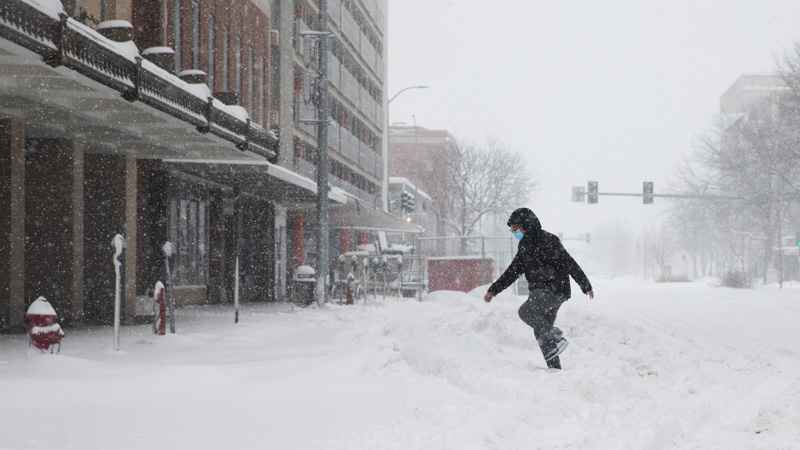Foot of snow blankets parts of Midwest, disrupts travel

A pedestrian steps in tire tracks while crossing the street during a winter storm in downtown Lincoln, Neb. on Monday, Jan. 25, 2021.[Kenneth Ferriera/Lincoln Journal Star via AP]
A major winter storm dropped more than a foot of snow on parts of Nebraska and Iowa, disrupting traffic and shuttering some schools, while blanketing other parts of the middle of the country with snow that continued to fall Tuesday.
There were early closures of several coronavirus testing sites on Monday in Nebraska and Iowa, and both states saw 12 or 13 inches (30.5 to 33 centimeters) of snow in places by Tuesday morning. At least 4 inches (10 centimeters) of snow was expected into Tuesday across most of an area stretching from central Kansas northeast to Chicago and southern Michigan.
National Weather Service meteorologist Taylor Nicolaisen, who is based near Omaha, Nebraska, said up to 15 inches (38 centimeters) was likely between York, Nebraska, and Des Moines, Iowa, and it has been at least 15 years since that area received more than a foot of snow in a single storm.
“This is historic snow,” Nicolaisen said of the snow in that area.
The storm was making travel treacherous as wind-whipped snow piled up Tuesday in Wisconsin, where a jack-knifed semi temporarily closed interstate lanes south of Milwaukee before dawn. The weather service predicted up to 10 inches (25.4 centimeters) of snow could fall in the Milwaukee area, with the highest totals along Lake Michigan.
Wind gusts of 15 mph (24 kilometers per hour) to 25 mph (40 kph) were reported across southern Wisconsin, creating drifting snow, reduced visibilities and complicating snow removal efforts, said Andy Boxell, a meteorologist with the weather service’s office in Sullivan, Wisconsin.
“It’s not only snow but it’s pretty darn windy out there, so that’s causing a lot blowing and drifting," he said.
In the Chicago area, between between 3 inches (7.6 centimeters) and 5 inches (12.7 centimeters) of snow had fallen by early Tuesday. Meteorologist Bett Borchardt forecast snowfall up to 8 inches (20.3 centimeters) or more in northern Illinois before the storm ends Tuesday evening.
The last comparable snowfall hit the area in November 2018, when 8.4 inches (21.3 centimeters) fell.
Many schools and businesses closed as the storm moved across the Midwest and officials urged drivers to stay off the roads. In western Iowa, Missouri Valley Superintendent Brent Hoesing reworked the lyrics of the 1970s hit “I Will Survive” to tell students in his district, “So Stay Inside."
Roughly 250 semi trucks waited out the storm at the Petro truck stop alongside Interstate 80 in York, Nebraska. Manager Rachael Adamson said she could see knee-high drifts and that sidewalks needed to be shoveled every half hour.
“We haven’t had this much snow in quite a few years," Adamson said.
In the South, one person was dead after a tornado tore through an Alabama city north of Birmingham on Monday night, leaving the area with crumpled buildings and downed trees.
Over the weekend, more than a foot of snow fell in Southern California’s mountains. Interstate 5 was shut down Monday in the Tejon Pass between Los Angeles and the San Joaquin Valley.
Until recently, California had been experiencing significantly dry weather accompanied by relentless wildfires. A band of clouds suggested more rain could fall Tuesday in areas north and south of San Francisco Bay, bringing the threat of possible flash floods and landslides in areas scarred by the fires.
A storm buried northern Arizona in snow on Monday while sending flurries to the outskirts of Las Vegas and Phoenix. And most of Nevada was bracing for another series of powerful winter storms that could bring several feet of snow to the mountains above Lake Tahoe by Thursday.
Preliminary snowfall reports from the latest storm included 14.2 inches (36 centimeters) at the Flagstaff airport and 16 inches (40.6 centimeters) at Payson between Sunday night and late Monday, the weather service said.